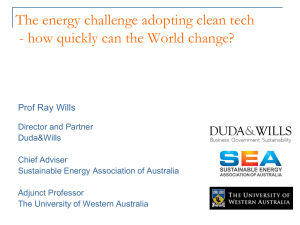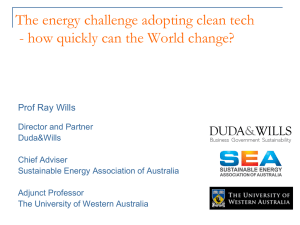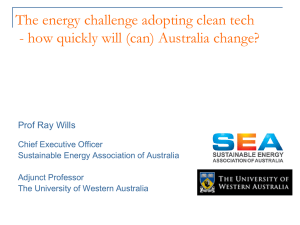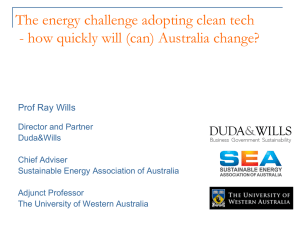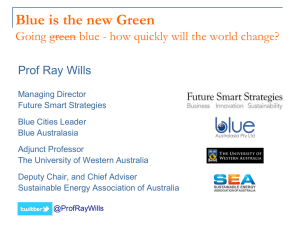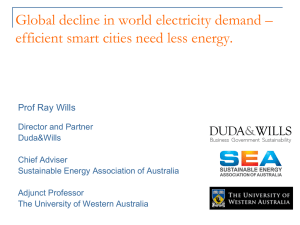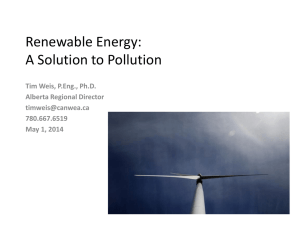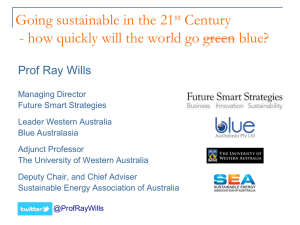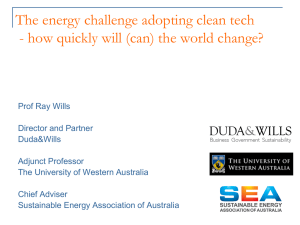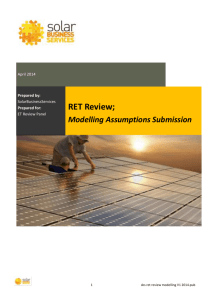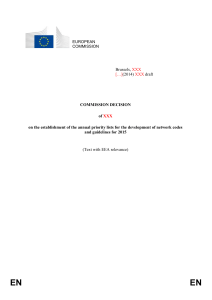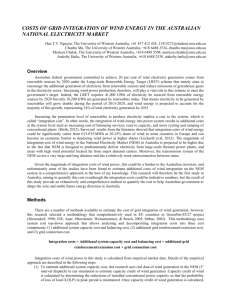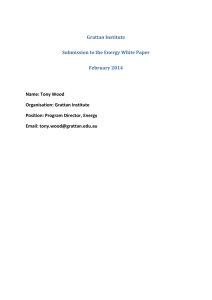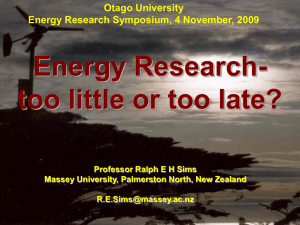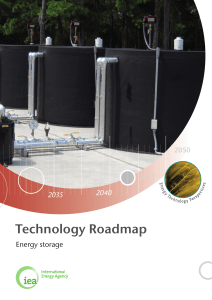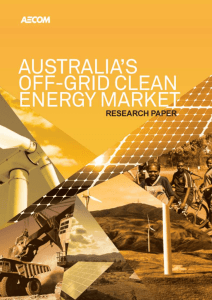Wills-carbonandbusiness-SA-DCCI
advertisement
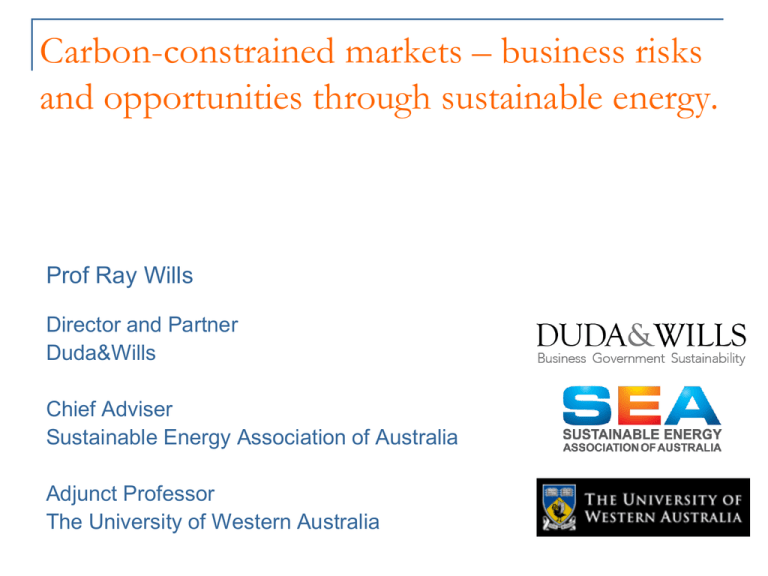
Carbon-constrained markets – business risks and opportunities through sustainable energy. Prof Ray Wills Director and Partner Duda&Wills Chief Adviser Sustainable Energy Association of Australia Adjunct Professor The University of Western Australia Adoption of technology The natural turnover and retirement of appliances, buildings and vehicles can bring about a modest penetration of sustainable energy in the next ten years. However, adoption of new technology is often not just ‘natural’ The transition to sustainable energy, like many new technology shifts, will be more rapid with changes favoured by: policy measures and regulation; consumer sentiment; pricing advantage. Roger’s diffusion curve Technology adoption rates – US Will electric cars be dishwashers or VCRs? (Will there ever be any more dishwashers??) NY Times Technology adoption rates - vehicles Zoepf 2011 Technology adoption rates - vehicles Zoepf 2011 Technology adoption - manufacturers Zoepf 2011 Technology adoption rates Can historic deployment rates be used to describe future technologies? Expect some similarities – just faster! Small-scale deployment for approximately five years - exponential growth and an inflection point ten or more years after first application Is there an opportunity for disruptive technology entry? Beginnings of disruptive innovation may be in market innovations, Vehicle ownership model (eg Better Place) could rapidly change the how and what is purchased Roof top solar – companies may own the panels on your roof Technology adoption rates Marked decrease in developmental lag Innovation/development of new products Supply side capabilities Market competition Growing consumer expectations Higher level of communication between consumers - blogspace Fleet/building/operations managers – and CFOs Regulation Energy security Trends in car prices and CO2 2002-2010 How clean are Europe’s cars? Wake up and smell the roses Buggy whips -> combustion engine -> EVs? (Electric) typewriter -> word processor -> PC PC -> desktop -> laptop -> tablet Landline -> mobile -> smartphone Record shops Vinyl -> CD -> (Apple Store) Book Shops Boutique -> mega -> (Amazon) Retail shopping Boutique-> chain/mega -> Internet Energy -> chopping wood -> coal -> solar Global electricity investment growth 500 450 400 350 300 Fossil dethroned* BNEF Renewable 250 Fossil BAU (estimated) BNEF IEA (estimated) 200 150 100 50 0 2004 2005 2006 2007 2008 2009 2010 2011 Global renewables Renewable energy growth Data IEA Global renewables 2013? Data UNEP Global electricity … IEA Energy Statistics 25 000 000 20 000 000 15 000 000 10 000 000 Coal/peat Oil World Statistics on the Web: http://www.iea.org/stats/index.asp Electricity generation by fuel Natural gas Hydro Biofuels & waste Geothermal/solar/wind For more detailed data, please consult our on-line data service at http://data.iea.org. Nuclear 0 1971 1973 1975 1977 1979 1981 1983 1985 1987 1989 1991 1993 1995 1997 1999 2001 2003 2005 2007 2009 5 000 000 © OECD/IEA 2011 GWh Global electricity growth - Europe Australian renewables 2011… The transformation of Australia’s energy mix has begun – in 2011 new electricity generation construction 25% solar, 31% gas and 33% wind. Coal-fired power currently 75% of Australia’s total generation - in 2011 only 14% of new investment was coal. This is still behind the average world-wide investment in renewable energy – China’s economy 8 times larger than Australia, investment in renewables over 20 times larger! Australian electricity … Data ABARES Australian electricity consumption 2012… Australian electricity consumption 2012… Data AEMO Electricity market projections – WA Solar on Australian homes Solar on WA homes City of Cockburn Sustainable energy and energy efficiency Energy efficiency in all forms Distributed, renewable energy Known costs, resource life 1000++ years Stored energy in commodities, desal Energy storage key to: improved energy delivery increased reliability reduced emissions Technology energy use www.epri.com Global electricity growth Rapid change - Personal mobility Private transport Fuel efficiency, other energy sources Transport Energy storage key New technologies may be disruptive Electric mass transit Commercial vehicles Smith Newton electric truck Mega electric diesel hybrids London Bus Haul Pak + Earthmover Mitsubishi Fuso Honda prime mover Oshkosh Military Vehicle Flying and floating fuels February 25, 2008 – Virgin Atlantic Stages the First Biofuel Flight October 30, 2007 - U.S.A.F. Tests New Synthetic Fuel on Plane February 14, 2011 – Qantas follows US Military to algae biofuels September 13, 2011 – US Navy announces by 2016 Green Strike Group, powered by renewable diesel-electric engines, nuclear power and aviation biofuels, is able to operate independent of fossil fuel supply line threat or disruption Smart grids, smart houses (and farms) Integrated energy planning Smart grids to coordinate the actions of devices such as loads & generators Green cities Global Australia Tianjin Eco-City China Ulsan Ecocity Korea Masdar City UAE City of Sydney – 70% CO2 reduction by 2030 City of Melbourne Stirling City Centre, Perth City of Fremantle Yanchep – 2 x 100 000 Local government critical www.seaaus.com.au
